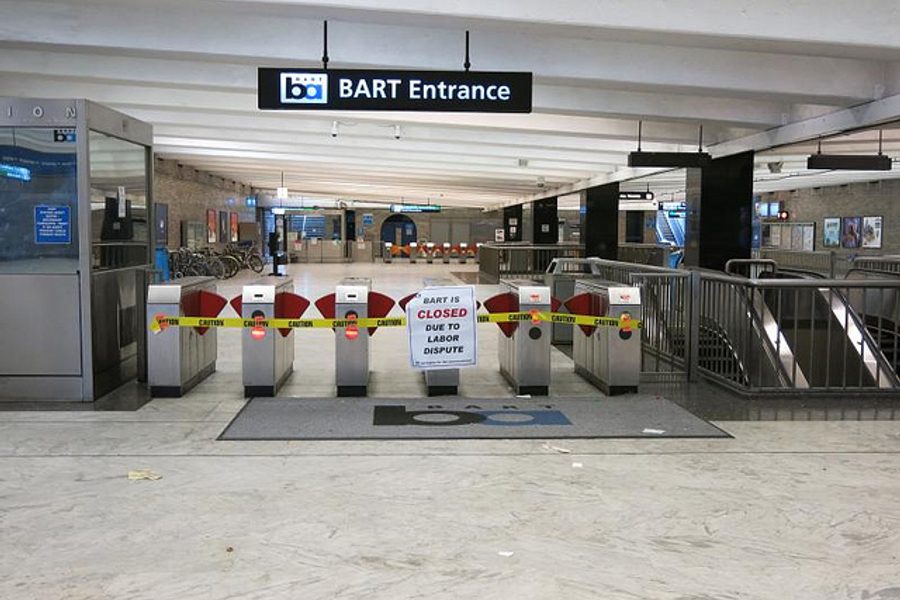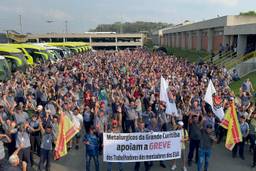
After a Bay Area Rapid Transit (BART) train fatally struck two workers on October 19, the BART union workers’ recent strike, which was on its second day, was catapulted into the national spotlight. The workers, 58-year-old engineer Christopher Sheppard and 66-year-old contractor Laurence Daniels, were hit by a four-car out-of-service train that was being run by a trainee at up to 75 miles per hour “in automatic mode under computer control,” according to media reports. The trainee was reportedly operating the train because of the strike, though the exact circumstances of the accident are still unknown.
Sheppard was a member of American Federation of State, County and Municipal Employees Local 3993, which represents engineers and supervisors and was not on strike. And as a contractor, Daniels was apparently not represented by a union.
The National Transportation Safety Board (NTSB) is investigating the tragedy; meanwhile, the strike ended late on October 21 with a deal described by pundits as a compromise — workers got raises while agreeing to begin contributing to their pensions, paying more for health care and accepting work rules changes. Meanwhile, general public frustration with the work stoppage and implications that the strike indirectly caused the October 19 fatalities have stoked a push for state legislation that would prohibit the transit workers from striking in the future.
Working In These Times talked with Craig Fleming, a member of the Service Employees International Union (SEIU) Local 1021 professional unit and a member of the progressive labor group Railroad Workers United (RWU). SEIU Local 1021 was on strike this month along with the Amalgamated Transit Union (ATU) Local 1555.
How would you describe the main reasons for the strike?
Wages were part of it. We had eight years — two contracts — with almost no wage increases. Eight years of basically nothing. Then there’s the cost of health care and the contributions to the pension. We gave back a lot to help keep that funded in the last contract. We expected some turnaround this time. After two contracts of drought, let’s get a little rain.
There were safety issues too, and aging infrastructure issues. One of the issues that still hasn’t been addressed is the lighting where we have to work. One of my electricians died back in 2001 — Robert Rhodes. He died in an area [at the 24th Street Mission station] with poor lighting and no adequate access for maintenance workers when the trains were running. It was an older part of the system, built back in the 1970s when BART was first running. That had been an ongoing problem for months and months. Finally someone gets killed and they decide to deal with it.
I came here in 1982, when the system was about 10 years old. Things were still in pretty good shape. But now you have these old substations [part of the electric infrastructure] which probably had a 30-year design life, going past 40 years. They keep saying they have capital improvement projects. Well, when are they going to start? They want to defer it, defer it, defer it — it’s kicking the can down the road. We had a substation in Hayward yard blow up in 2008: a total meltdown where we had to move jobs to Daly City because [Hayward] didn’t have power for over a year. Luckily, no one was hurt, but it was $20 million worth of damage.
BART general managers say the employees are taking all this money away from our needed capital improvements — well, that’s a lie. I’m hearing the labor budget for all the unions is only about $200 million, versus $1.5 billion for the entire operating budget. For us to endure the last eight years of zeros while they do all these glamorous expansions but let the basic infrastructure deteriorate — what’s that about?
Do you blame management for not addressing safety issues?
We hired a new general manager two years ago [Grace Crunican, former Seattle director of transportation]. She came in and talked about a culture of safety, but we saw that quickly evaporate. They said BART needs a culture of safety, but really they have a culture of secrecy. Then we saw this union-busting negotiator come in — Thomas Hock, a hired gun who goes around the country helping transit authorities break unions. They hired him for $399,000, with board approval. All these people call themselves progressives in San Francisco and Oakland, and yet they hire this guy who’s a known union-buster, who’s negotiating benefits downward.
Hock goes away for vacation about two weeks ago … things were basically improving while he was away, we basically had an agreement on wages and benefits, then they throw in this poison pill on work rules [that determine how overtime pay is calculated and other measures]. He was just there to poison the well. Hopefully we’ll never see him again. But we’re expecting BART to end up with a no-strike clause.
What do you say to those who argue essential public employees like BART workers should not be allowed to strike?
It takes away a basic right of workers to withdraw their labor and force the district to do something. It’s one of the few weapons we have. The right to strike is a basic right that all workers should have, no matter how “essential” we’re deemed.
Did the strike contribute to or cause the accident?
Managers probably outside the union were driving trains [including the train that killed the workers] — they’ve been doing this for several months in a simulate mode … They were trying in a couple weeks to get these people enough training to be scab operators.
Trains are remarkably quiet — they can sneak up on you. By the time you turn around, you could be facing one head-on. That’s why it’s essential to be clear of the track at all times and only cross the track when there’s a watchman looking both directions. Both the guys [who were killed] were walking away at the same time. You never do that. It just shows the complacency that can set in when people don’t do this job on a regular basis. When the people who are supposed to be doing it are out on strike, this is the kind of thing that can happen.
Whether it’s being hit by trains or run over by maintenance vehicles, this is an extremely dangerous environment. People think any idiot can go out there and push buttons to run trains. That’s not true. We get these wages because we’re skilled and we can avoid danger generally. The engineer [Sheppard] who was out with the contractor, I doubt he went out on the tracks much. It turns out that a lot of the [lower-grade] engineers I’ve seen do worse than us [regarding safety procedures] because they’re not out on the tracks on a daily or weekly basis like we are. They don’t have the experience.
What are some of the safety improvements needed? Will the accident lead to more focus on safety?
We’re going to need new procedures, and maybe slower speeds. BART was resisting lowering the speeds [at the location where the two workers were killed]. The automatic speeds are just too fast. You have more reaction time the slower the speeds are. If you lower it to 27 miles per hour, the operator has more time to see people in front of them, and maintenance workers might have more chance to react.
We’ll see what happens. There will definitely be more scrutiny — we’ll wait and see what the NTSB’s recommendations end up being. There’s a lot more to come, and there will be more happening, especially with a dual fatality like this. It’s a tragedy that’s what it took [to make changes].

I hope you found this article important. Before you leave, I want to ask you to consider supporting our work with a donation. In These Times needs readers like you to help sustain our mission. We don’t depend on—or want—corporate advertising or deep-pocketed billionaires to fund our journalism. We’re supported by you, the reader, so we can focus on covering the issues that matter most to the progressive movement without fear or compromise.
Our work isn’t hidden behind a paywall because of people like you who support our journalism. We want to keep it that way. If you value the work we do and the movements we cover, please consider donating to In These Times.
Kari Lydersen is a Chicago-based journalist, author and assistant professor at Northwestern University, where she leads the investigative specialization at the Medill School of Journalism, Media, Integrated Marketing Communications. Her books include Mayor 1%: Rahm Emanuel and the Rise of Chicago’s 99%.







